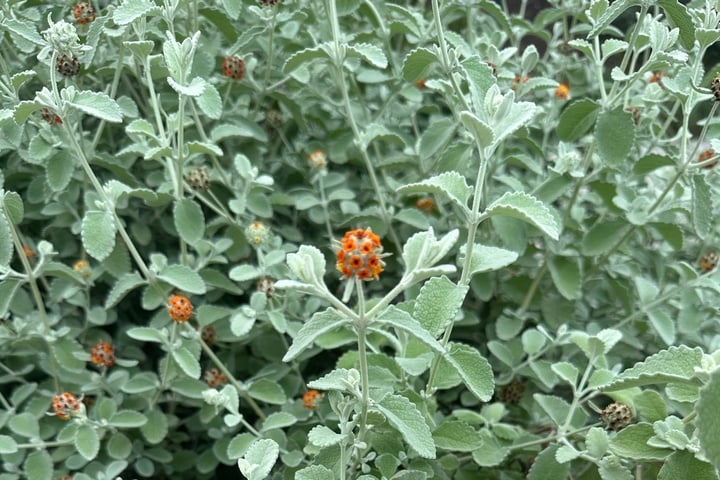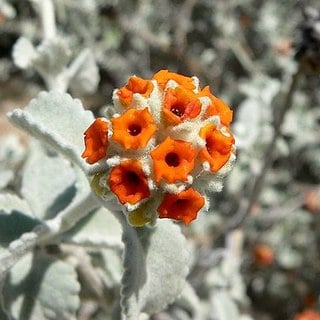If you want to attract butterflies into your yard, consider growing woolly butterfly bush. Butterflies are wildly attracted to its dainty flowers. Here’s everything you need to know about growing this aptly named Chihuahuan Desert native in this complete care guide.

Woolly butterfly bush (Buddleja marrubiifolia) is one plant that lives up to its name. This shrub’s silvery gray leaves are woolly and butterflies flock to it when in bloom. They find its flowers simply irresistible.
The flowers are surprisingly inconspicuous for a pollinator magnet. Each marble size “flower” is actually a cluster of tiny orange flowers. For their size, they produce a lot of nectar that pollinators can’t resist.
As a Chihuahuan Desert native, this shrub tolerates full sun, drought, and temperature extremes. It’s an extremely low-maintenance landscape plant that suffers more from too much attention (watering, pruning) than from neglect.
It is largely resistant to rabbits and javelinas.
Why I Like This Plant
- Silver gray foliage all year
- Dainty orange flowers much of the year
- Extremely low maintenance
- No thorns, low litter
- Attracts butterflies, bees, hummingbirds
Things to Watch Out For
Woolly butterfly bush attracts all kinds of pollinators, including bees. Plants can sometimes literally hum with bee activity, so it’s not a good choice if you are afraid of or allergic to bees.
This is a casual, informal shrub that should be left to grow in its natural form. It should not be pruned into a hedge, ball, or other formal shape. That may or may not be the look you’re going for.
Optimal Growing Conditions
If you’re thinking of adding a woolly butterfly bush to your garden, you need to find a suitable place that will keep your plant healthy and looking good… while minimizing maintenance for you.
Here are the key factors to keep in mind.
Temperature
Woolly butterfly bush should be grown in USDA Hardiness Zones 8 – 11. It’s a heat loving plant that tolerates cold down to the mid-teens. It can withstand the hot summers of Phoenix and the cold winters of Prescott. It may experience some cold damage when grown in Zone 8, but should recover in the spring.
Sun Exposure
As a Chihuahuan Desert native, woolly butterfly bush likes full sun and doesn’t mind reflected heat. They tolerate some shade, and actually attract more butterflies when they get some relief from the sun. However, plants get leggy with too much shade.
Size and Growth Rate
Woolly butterfly bush grows moderately fast. Plants typically reach a size of 5 feet tall by 5 feet wide. A plant’s growth rate somewhat depends on how much water it receives.
Plants bloom most heavily in the spring, but often flower on and off throughout summer and fall and can even bloom in during mild winters.

Soil
Woolly butterfly bush is not particular about soil. It grows well in most native soil — rocky, sandy, or gravelly — provided it’s well-draining.
Other Location Considerations
Since it is non-toxic, has no thorns, and is low-litter, it’s a plant you can place near a sidewalk, driveway, pool, or patio, or anywhere else it might come in contact with people or pets. But, of course, be mindful that it can attract bee activity.
Woolly Butterfly Bush:
The Essentials
| Common Name | Woolly butterfly bush |
| Scientific Name | Buddleja marrubiifolia |
| Origin | Chihuahuan Desert |
| Plant Type | Evergreen shrub |
| USDA Zones | Zones 8 – 11 |
| Cold Hardiness | To 15℉ |
| Flower Color | Orange |
| Flower Season | Spring, summer, fall |
| Mature Size | 5’ high x 5’ wide |
| Growth Rate | Moderate |
| Sun Tolerance | Full, part, reflected sun |
| Water Needs | Low |
| Pests & Diseases | Aphids Root rot if overwatered |
| Garden Friendly | No thorns, non-toxic, low litter |
| Wildlife | Attracts butterflies, bees, hummingbirds Rabbit, javelina resistant |
How to Plant
The rule of thumb when planting any shrub in the desert is to dig a hole three times as wide as the root ball but no deeper. Amending the soil is not recommended. Counterintuitively, backfilling with the same native soil you just dug up helps your plant develop a stronger root system.
When to Plant
The best time to plant woolly butterfly bush is in the fall. This gives your shrub three seasons to grow roots and get established before the following summer.
The second best time is in spring, the earlier the better. This still gives your plant time to get established before the intense heat of June arrives.
How to Care for Woolly Butterfly Bush
Whether you’ve recently planted a woolly butterfly bush or have an existing plant in your yard, here’s how to take care of it to keep it healthy and looking its best.
How to Water New Plants
Once you’ve got your shrub in the ground, watering is your most immediate concern. Here is the recommended watering schedule for new shrubs planted in the spring or fall.
| Weeks 1 & 2 | Every 3 – 4 days |
| Weeks 3 & 4 | Every 5 – 7 days |
| Weeks 5 & 6 | Every 7 – 10 days |
| Weeks 7 & 8 | Every 10 – 14 days |
After week 8, gradually extend the time between waterings.
How to Water Established Plants
Once your plant is established, water it twice per month during the summer and once per month in spring and fall. There’s no need to water during the winter, unless you’ve experienced extreme drought.
Plants can survive on rain alone but will look better, grow faster, and produce more flowers with some supplemental water.
Take care not to overwater this plant. Too much water can cause root rot and results in fast but floppy growth.
Should You Fertilize?
While you can fertilize once a year in the spring, you don’t have to. This plant has evolved to get all the nutrients it needs from desert soil.
How to Prune
Woolly butterfly bush doesn’t need regular pruning. You can lightly prune in the fall to shape or remove any dead or damaged branches.
Don’t try to prune this informal shrub into a hedge or make it look like a manicured shrub. It won’t be happy.
Pests & Diseases
Woolly butterfly bush is not prone to pests or diseases, but sometimes attracts aphids. You can leave them alone, they rarely do harm, and wait for one of this plant’s many insect visitors to take care of them. Or you can remove them with the jet spray of your hose.
Plant Lover Facts
Woolly butterfly bush (Buddleja marrubiifolia) is native to Texas and Mexico. It’s sometimes spelled wooly (one “l”) butterfly bush.
You may see the genus sometimes spelled as Buddleia (with an “i” instead of a “j”), but that’s no longer considered the correct spelling.
You may have heard that butterfly bush is invasive and are concerned about planting woolly butterfly bush. The invasive butterfly bush is Buddleja davidii, a popular shrub with purple flowers. It’s considered invasive in many US states with temperate climates, and has escaped cultivation on six continents. But woolly butterfly bush is a desert native that is not considered invasive in anywhere in the world.
Did you enjoy this article?
Sign up for our weekly newsletter
where you’ll find more great info on creating &
maintaining a beautiful, carefree desert landscape.
Author Bio
Deane Alban is the creator of Southwest Gardener. She is a science writer with a bachelor’s degree in botany from the University of South Florida. Gardening is her lifelong passion. She’s been gardening in Tucson for over 15 years.

Photo Credits
valsalinasdavis, CC BY-SA 4.0, iNaturalist
Stan Shebs, CC BY-SA 3.0, via Wikimedia Commons
